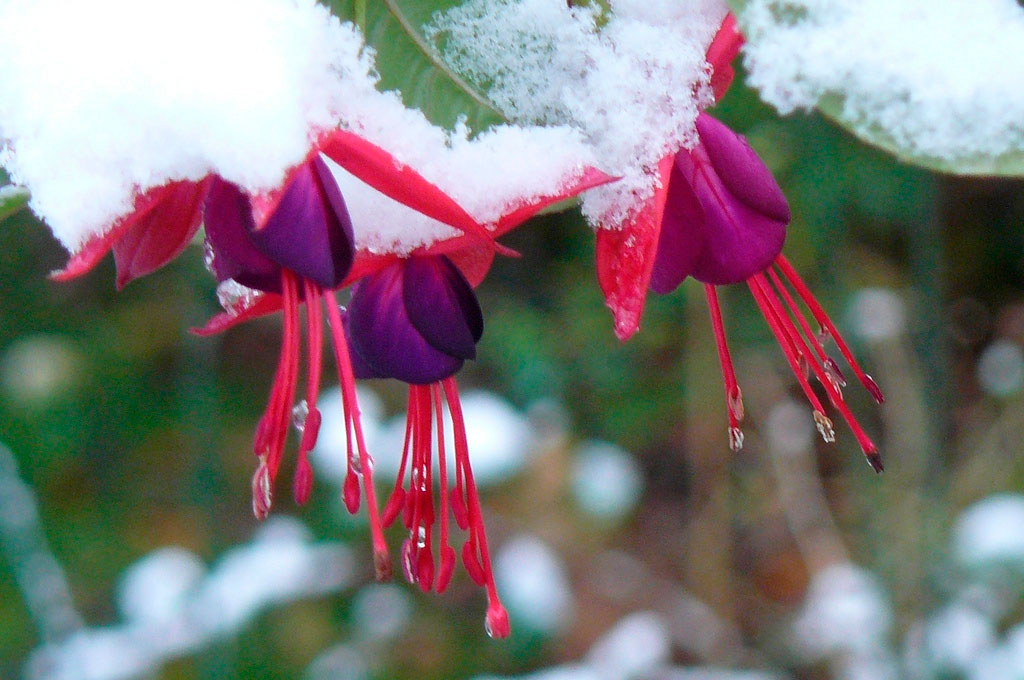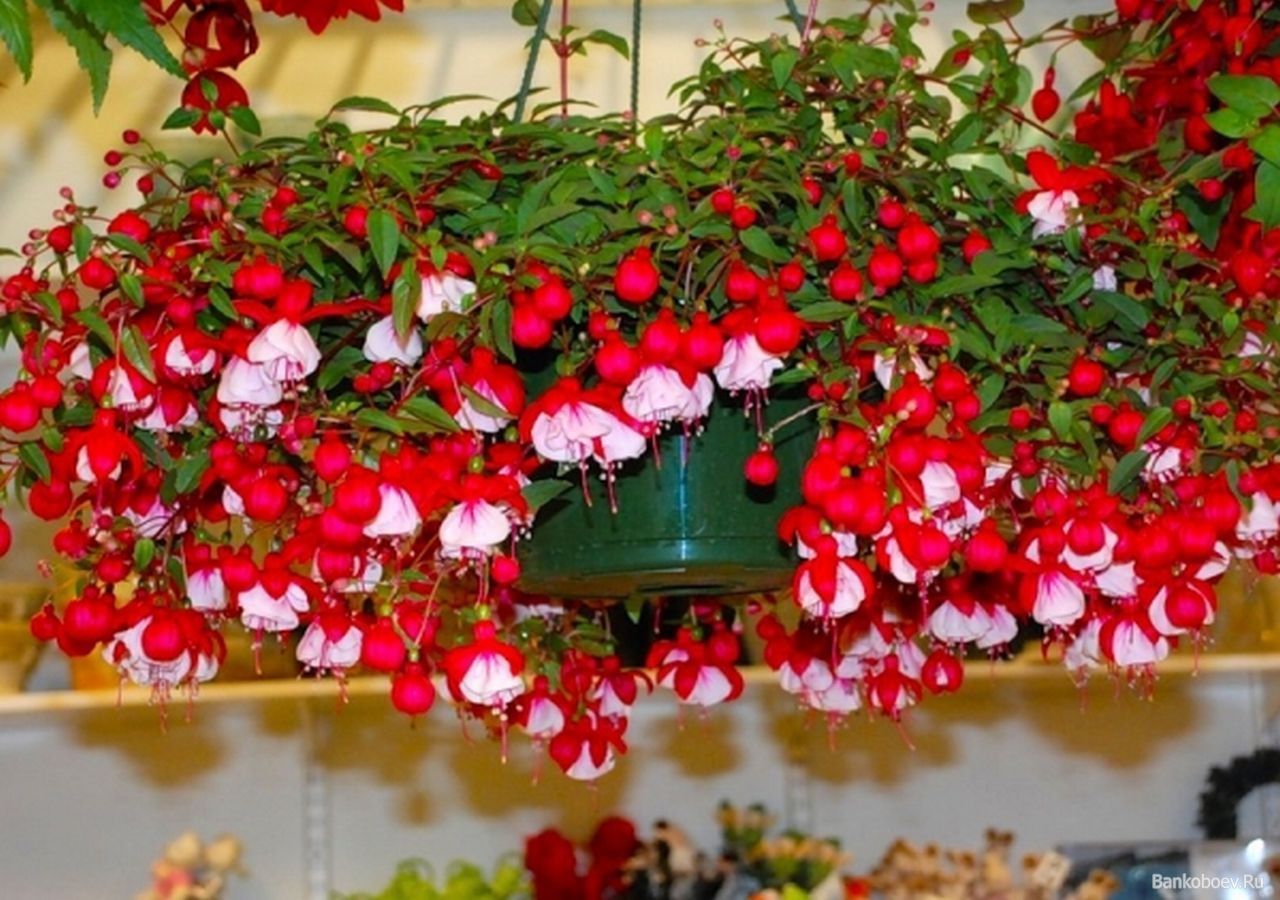The plant, sometimes called the "flower of the elves", is a well-known fuchsia. The shades of the flower vary in huge numbers, it is not picky, it can easily be grown and propagated even by a novice gardener in his apartment. How on your own grow fuchsia and competently look after for this plant in the winter at home?
Content
- 1 Growing and Care Tips
- 2 Preparing for fuchsia for wintering
- 3 Plant preservation in the basement and in the cellar
- 4 How fuchsia suffers winter in an apartment
- 5 How to care for fuchsia placed on the windowsill
- 6 Do I need to crop and how to do it
- 7 Flower propagation
- 8 Winter care for fuchsia
- 9 Possible wintering diseases
- 10 Awakening of Fuchsia in the Spring
- 11 Conclusion
Growing and Care Tips
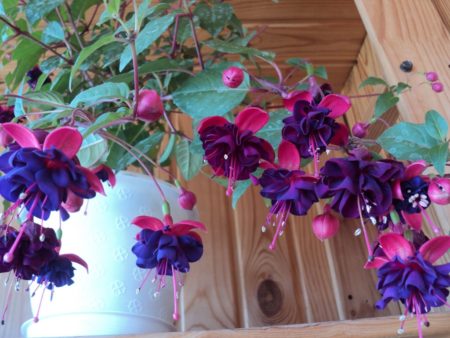
Fuchsia will become a real joy if you provide it with comfortable conditions for the entire process of flower growth - from planting to resting between seasons. It is important to know the rules for caring for fuchsia, and especially during the wintering period at home, which depend on its place of growth (open ground or flowerpot).
Watering
Fuchsia belongs to those plants that love moisture. The shrub tolerates both spraying and watering directly at the roots. It is necessary to carry out watering in small doses every day. A lack of moisture will become noticeable when the soil dries to a depth of 1 centimeter. But do not get carried away, as the brute force will steadily lead to the formation of mold and rotting of the roots. This situation can be prevented if you create a drainage layer using expanded clay or carefully pebbled pebbles.
Shine
Fuchsia is a heat-loving flower, but do not place it under the influence of sunlight. The presence of reflected light and partial shade is sufficient. When choosing the location of a flower, it is worth considering the aspect of contrast. For flowers of dark shades, a greater amount of light is required, and flowers of light shades will feel good in a dark corner.
Soil mixture
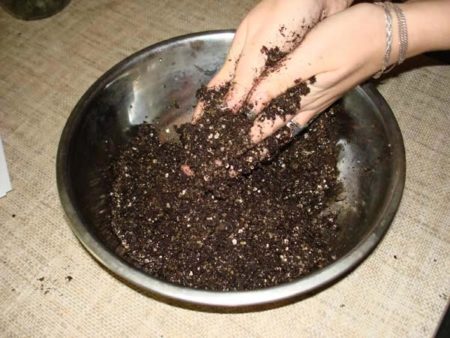
The best soil mix for fuchsia is considered chernozem soil with deciduous humus. It is necessary to feed the flower regularly. When flowering, it is necessary to apply fertilizers of natural origin with a small fraction of nitrogen. Fertilizers are used in combination with irrigation fluid, but you can also add it directly to the soil.
Room temperature
Fuchsia arose in countries with a warm climate, but high temperatures are not a suitable condition for its growth. At temperatures above 25 degrees above zero, the plant wilts. In summer, fuchsia should be hidden from exposure to the sun, placing the flowerpot in a colder place, and create a shadow for the flower garden.
Preparing for fuchsia for wintering
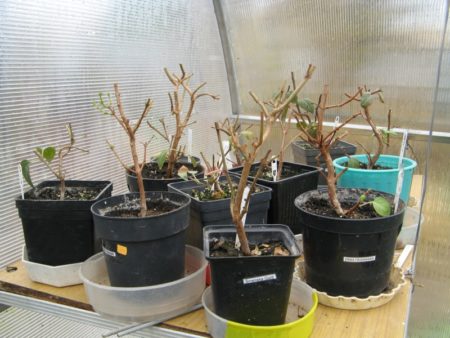
In winter, the dormancy stage begins in the flower’s “life”, which is explained by the habituation of fuchsia to such climate conditions, when the temperature decreases, and the light of the sun is extremely small for normal life. Fuchsia needs to rest, restore energy reserves and prepare for future flowering. Preparation Tips:
- Reduced watering.
It is necessary to reduce the amount of watering in stages. Completely stop watering the flower is a month later. It is necessary to start reducing watering in the first month of autumn, since then fuchsia will be completely dehydrated until the first frosts. - Cessation of plant nutrition.
Stop feeding fuchsia is necessary to stimulate the dropping of foliage and flowers. An action of this nature is a "sign" for fuchsia about the need to reduce activity. - Reducing the amount of incident light.
It is necessary to place the plant at a sufficient distance from the window. Only light reflected from the ceiling and walls should fall on the plant. If it is not possible to create such conditions, a lamp is suitable, which must be turned on once a day for a couple of hours. - Temperature reduction.
The pot should be placed on a glazed balcony, left in the basement or in another place in which the temperature is not more than +15oFROM.
Plant preservation in the basement and in the cellar
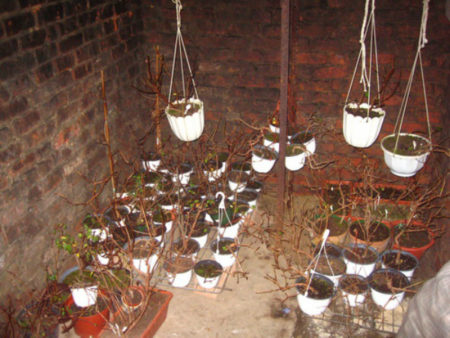
To preserve fuchsia in the cold season, it would be advisable to place it in the basement. But we should not forget that before moving the plants need to shorten the leaves.
In the absence of light, the plant breathes in the same way as in open space, that is, the consumption of useful elements occurs. The room should be well ventilated, otherwise humidity will rise, which will cause the appearance of the fungus.
How fuchsia suffers winter in an apartment
Not everyone has the opportunity to put fuchsia in the basement for the winter. It is believed that it is quite possible to form comfortable conditions for wintering fuchsia at home, however, it is worth considering that regular ventilation of the room is required. With the advent of autumn, cuttings of plants are transplanted into the soil with a small proportion of humus, which slows down the growth of young shrubs.
If in the winter season the gardener observes the germination of fuchsia, he needs to without hesitation cut off the excess and lower the air temperature to a greater extent by opening the windows as wide as possible. The shoots are not necessary to dispose. Their rooting should be done by lowering them into water. Fuchsia should be placed on a well-lit window sill. If watering the fuchsias left in the basement should be watered once or twice in 30 days, then watering the species wintering in the apartment should be done more often.
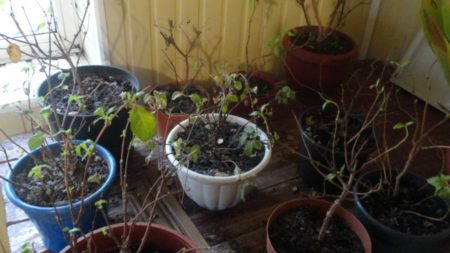
The central heating system contributes to the rapid drying of the earth, and a low level of humidity - the death of fuchsia. In this regard, on the first day of her appearance in the apartment, it is necessary to open the windows using the micro-ventilation mode. Windows should be kept open at all times, except during moments of increased cooling. At rest, fuchsia is more finicky than with growth, since it does not have the best response to excess and insufficient moisture. Without the necessary conditions, with a high level of humidity and temperature, insects will begin to appear. Medications such as fungicides may not help in resolving the problem.
Usually fuchsia is left to winter at the end of the second month of the autumn period. The plant hibernates before spring.
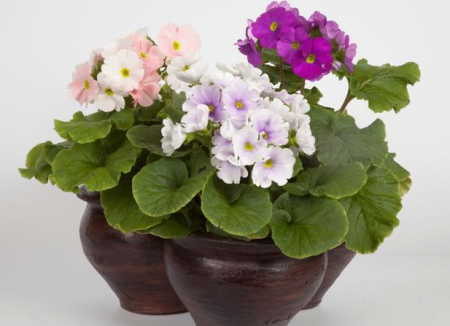 You may be interested in:
You may be interested in:How to care for fuchsia placed on the windowsill
The flower should be ventilated continuously, that is, it must be positioned as close to the window glass as possible. It is necessary to insulate the bottom of the pot with foam, this will help prevent rotting of the root system due to cold air. To protect the plant from dry air, covering it with a film of polyethylene, it is necessary if the room is hot enough. It is necessary to water fuchsia not too often and not very abundantly, and also one should not forget about the treatment with specialized substances from parasites. In the first two months of winter, the flower must be highlighted with lamps due to insufficient daylight.
Do I need to crop and how to do it
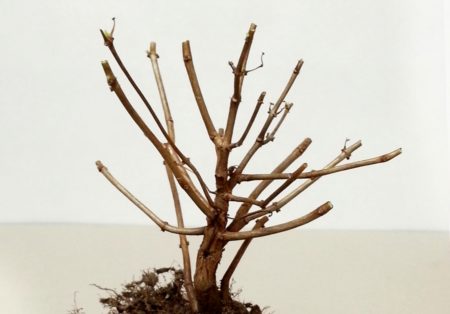
Trimming fuchsia before wintering is a must.Perform this operation twice a year:
- In the autumn, when transferring the flower to the basement or home.
- In the spring, in order to construct an attractive form.
Branches of fuchsia should be cut to approximately 0.5 lengths. This is due to the fact that the immature part is removed, and with it the foliage. You also need to trim the root lump to a volume that fits in 2 hands. After the preparation, the bush is placed in a box. You can add moist moss to the box, which will insulate the plant and retain moisture.
Flower propagation
Reproduction of the bush can be done independently at home.
Breeding methods:
- seeds;
- cuttings.
In the first case, the “new” fuchsia can be very different from the parent plant, as it self-pollinates or bees participate in pollination. When grafting on a bush, it is necessary to trim the shoot, the length of which does not exceed twenty centimeters. After the gardener removes the leaves from the bottom of the plant, the root must be placed in purified water. When young roots appear, the stalk should be transplanted into the ground.
When fuchsia has grown enough, it must be transplanted into a larger pot. Transplantation should be carried out every year in the autumn or spring, providing free space for growing roots.
Propagation by cuttings
- You must select a green apical shoot with two or three leaf axils. A well-sharpened knife should trim the shoot at an angle of approximately 45 degrees. Then you need to leave the handle literally for ten minutes. Large leaves (with a large number of them) must also be cut to facilitate rooting.
- Next, you need to “dust” the slice with a root stimulant (for example, “Kornevina” is perfect).
- To root the stalk in a light soil mixture. Then you need to prepare the container and put in it a moistened mixture to a depth of three centimeters, deepen the stalk there and moisten it using a spray gun.
- To increase the degree of humidity you need to use a transparent bag. It is necessary to put a container inside it, inflate the bag, tie it, and then put the whole structure on a well-lit window sill. In this case, there should not be a direct effect of the sun on the stalk (the optimum temperature is 20-25 ℃).
- Once a day (or even once every 2 days) you need to untie the package for the purpose of ventilation. If necessary, you can spray the cuttings and the ground, thereby preventing drying out.
- After about 2 weeks, small roots will appear. When the roots grow, the stalk can be transplanted into a small container. It is important to apply light soil.
The pot with the handle inside must again be wrapped with a bag, which is no longer necessary to tie, you can only raise the "walls". - After a few days (up to seven), the package can be removed, given that the plant is not sluggish. If this happens, you need to create conditions that are even closer to greenhouses. It is necessary to spray fuchsia, inflate the bag, tie it up and wait for the plant to recover, not forgetting about proper care.
Seed propagation
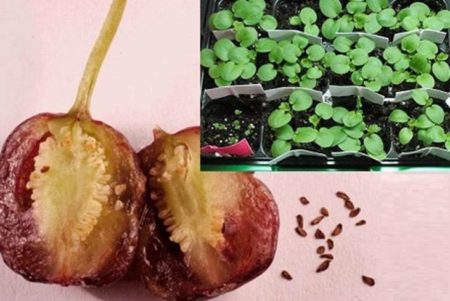
- Fuchsia should be grown with seeds in February, using light soil. You can buy soil in a garden store. However, it is not difficult to make a soil mixture from turf soil, peat and sand (3: 2: 1) on your own. Before sowing, the soil must be compacted, moistened and sprayed with a pink solution of potassium permanganate.
- The tray must be covered with cellophane and put on a warm and well-lit window sill. The temperature should be between + 18 ° and + 22 °. It is important to ensure that the sun does not fall directly onto the tray.If the soil is moist, you need to raise the film several times a day to remove condensation. With dried soil, carefully spray the ground near the sprout (the water should be at room temperature). After about a month, small shoots will begin to appear. At this point, you need to start removing cellophane from the tray for a long time, so that the shoots are gradually accustomed to room conditions, and then the shelter can be removed altogether.
When a second pair of leaves appears, the sprouts need to be dived into separate small containers. It is important to water the plant to prevent the soil from drying out. It should be sprayed from time to time and fertilize the sprouts with mineral fertilizers twice a month.
Winter care for fuchsia
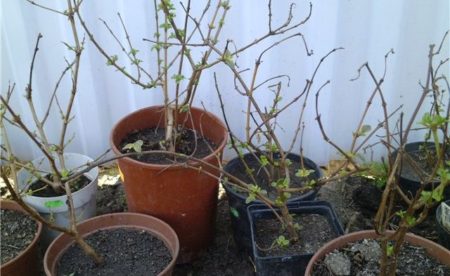
The plant does not really need top dressing, the main thing is to water it in time and maintain the optimum temperature (10 degrees above zero). Do not place the pot on the windows of the north side, as the flower will receive a small amount of lighting, which is fraught with its stretching.
The beginning of March is the most optimal time for awakening fuchsia. Winter-resistant fuchsia can be left in the garden, but covered with a peat layer or dry foliage. A plastic film helps eliminate excess moisture.
Possible wintering diseases
In winter, the plant can be affected by rust, which is due to neglect of tips for creating comfort conditions. Indoor should be warm, humid, and there should be little light. To prevent the appearance of rust, it is necessary to treat the flower with a 1% solution of Bordeaux mixture, but often they do not because of the appearance of dark spots on the leaves. Most often, both the affected plant and those standing next to it die. When rust appears, you must immediately save the plant with a mixture of five liters of water, 15 g of copper sulfate and 200 g of green soap.
Gray rot occurs when the air is wet. When a part is damaged, the flower becomes soft to the touch, and a white coating appears on the leaves. To eliminate the problem, it is necessary to trim the affected leaves, treat them with specialized substances and change the microclimatic conditions.
Awakening of Fuchsia in the Spring
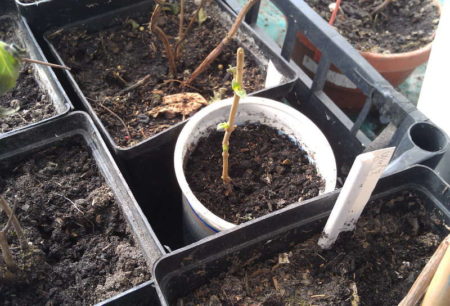
When the flower wakes up, the temperature regime should not rise sharply. It is necessary to gradually increase the temperature of the flower, moving it to places with different temperature marks.
The room must be well lit, however, the plant should not be directly affected by sunlight.
You need to immediately inspect the roots, due to the fact that they may have formed damage. If there is damage, the roots need to be trimmed, then soak them in water and stimulants, and the aerial part should be sprayed with water. By adding magnesium sulfate in powder form to the spray mixture (in accordance with the instructions), the gardener will help the flower to awaken new buds. To accelerate this process, the bush can be covered, providing a high level of humidity and prolonging the action of magnesium sulfate.
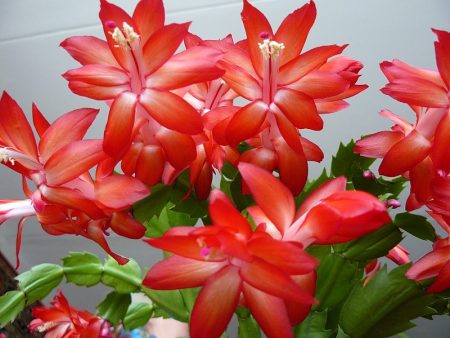 You may be interested in:
You may be interested in:Conclusion
To ensure the comfortable existence of fuchsia in the winter, you can even not carry out its transfer to the basement. She will perfectly tolerate the winter on the windowsill with occasional watering, spraying and proper temperature conditions.

